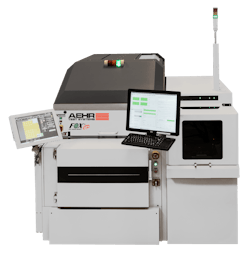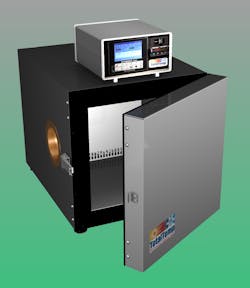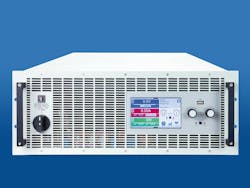Special Report: Burn-In is Hot Test Topic
Download this article in .PDF format.
Burn-in and test is an important step in the development and production of products ranging from semiconductors and modules to consumer appliances and military equipment. For the semiconductor industry, an application area such as automotive manufacturing, with the attendant demands for safety and reliability, is putting increasing emphasis on device burn-in. Across all application areas, engineers are looking for easy-to-use, automated, cost-effective systems that operate at high speeds and at low cost.
To learn more about this test topic, EE gathered commentary from makers of burn-in and test systems and related equipment and instrumentation to get their thoughts on technology trends and challenges, customer demands, and what newer solutions are on the market. Read on to see what they told us.
What’s trending?
What new or ongoing technology or market trends are vendors seeing in the area of burn-in test?
Vernon Rogers, executive vice president, Aehr Test Systems: “We see the resurgence of full production burn-in driven by the increasing consumption of semiconductors in the automotive market. Found in infotainment, engine control, and safety features, compound semiconductors in electric and autonomous/self-driving cars are requiring 100% burn-in of these devices due to their natural material properties and the infancy of compound technology being used in a robust-product-requirement market.”
Brian Hsu, USA product marketing manager, Preen AC Power Corp.: “The new trends for the burn-in testing require more flexibility on the power source for powering up the unit-under-test (UUT) as well as higher efficiency. And customers sometimes may require a bidirectional power source.”
Joe Gorley, product manager for DMMs and switching at Tektronix: “For this type of testing, engineers want as much measurement capability and test capacity as they can get from individual instruments so that the same instrumentation can be used in many types of test systems. As well as flexibility, test engineers need more speed to reduce test times and test costs. They also want ease of use and fast intuitive set up.”
Challenges
What key challenges are burn-in test solution vendors or their partners facing today?
Rogers, Aehr Test Systems: “The traditional semiconductor industry faces the challenges of cost and increasing technology requirements. Heterogenous (previously MCM) packaging technology is enjoying a large re-emergence driven by the limits of shrinking CMOS process technology, and the use of new compound-semiconductor process materials combined into modules are achieving much lower yields after the burn-in process. Production burn-in times of 12 to 24 hours are now extending to days before the fault surfaces—driving the overall production and scrap material cost up significantly. To reduce the scrap module material while reducing the production costs, wafer-level burn-in is being utilized more extensively by enabling thousands of devices to be burned-in in parallel, and detecting device faults before integration into the module.”
Booher, TotalTemp Technologies: “[We address challenges through] better automation features, such as cascade temperature control for optimum achievement of temperature set point, along with alarm features that can alert test operators by text or email when a test is complete, before damage is done or time is wasted.”
Hsu, Preen AC Power Corp.: “For burn-in testing, most applications do not require very sophisticated features on the power source. The main requirement is to simulate the AC power (adjustable voltage and frequency) or DC power to feed into the UUT. If using high-end programmable power supplies, the cost will be too high, and the total kVA may require certain quantity of supplies to be connected together in parallel. If a customer is using a variable transformer, there is no regulation on the voltage and no flexibility to change the frequency. The market needs something in between.”
Gorley, Tektronix: “An ongoing challenge is to find ways to increase measurement speeds and reduce test times while also improving accuracy and versatility. Another challenge is the need to enhance communication and control capabilities, which can help to reduce test times. Instruments must also be able to accommodate multiple interface options, such as USB, Ethernet, or GPIB. And no one likes down time, so there’s constant pressure to widen calibration intervals.Standards
What recent or upcoming compliance regulations, if any, are impacting the field of burn-in test? Rogers, Aehr Test Systems: “Compliance requirements with automotive communications protocols such as PSI5 and QMS standards such as IATF 16949:2016 may impact the field of burn-in test.
What are customers asking for? What key features or attributes are customers asking for in burn-in test solutions?
Rogers, Aehr Test Systems: “Customers are asking for massively parallel testing with individual die supplies, and they are asking for the monitoring of voltage, current, and thermal properties in real-time during the burn-in process.”
Booher, TotalTemp Technologies: “Customers are all about efficiency, and custom test solutions often result in a much more effective test than a cheap off-the-shelf solution.”
Eric Turner, general manager, E-A Elektro-Automatik USA: “For power supply testing, customers are asking for energy-saving techniques, including high-efficiency programmable sources and regenerative loads.”
Hsu, Preen AC Power Corp.: “Customers are looking for high efficiency, high power, adjustable voltage and frequency for AC supplies, adjustable voltage and current for DC supplies, and bidirectional operation.”
Gorley, Tektronix: “More intuitive test set up—As existing test equipment becomes obsolete, new models need to be straightforward to use, helping long-time users of the replaced equipment quickly come up to speed on the new tools. Compatibility—While equipment vendors are quick to put in new and better features, test standards change more slowly. Not only will an operator look for similar user controls, they will look for common remote programming commands. Additionally, they are looking for similar hardware options or accessories. Other features customers want include a greater number of on-instrument saved setup options to promote quick recall of standard test configuration settings; greater speed of test set-up on a statistically significant number of devices; greater ease in connectivity and/or remote monitoring of test status while the test is in progress; and a comprehensive options for graphical or tabular display of data on instrument or via software.”
Now on the market
Rogers, Aehr Test Systems: “We introduced in early 2019 two new models in our FOX family of wafer-level systems to complement our FOX-XP production system, which can burn-in up to 18 wafers at a time. The FOX-NP was introduced in January 2019 as a low-cost entry-level system to provide a configuration and price point for companies performing initial production qualification and new product introduction. This enables an easy transition to the FOX-XP system for high-volume production burn-in test. The FOX-CP was introduced in February 2019 and is a new low-cost single-wafer compact test and reliability verification solution for logic, memory, and photonic devices where test times range from minutes to a few hours or where multiple touchdowns are required to test the entire wafer. It complements the capabilities of the FOX-XP and FOX-NP systems, which are optimal when the test time is measured in hours or days and the full wafer can be tested in a single touchdown.”
Booher, TotalTemp Technologies: “Our hybrid benchtop chamber allows customers to apply the thermal stress of different temperatures at the same time or the ability to transition quickly with the combination of convection and conductive heat transfer. We also have a new line of benchtop wide-range temperature chambers.”
Turner, E-A Elektro-Automatik USA: “Power-supply burn-in test equipment like E-A’s latest generation of programmable sources and programmable loads utilize SiC power semiconductors to improve performance and efficiency. This new line of equipment is capable of 30-kW power (sources and load) in a 4U rack. Products in this series also include bidirectional source and load capability with regenerative output that returns over 95% of the test power back to the utility source.”
Gorley, Tektronix: “The Keithley DAQ6510 6½-digit data acquisition and logging multimeter system can test up to 80 devices in one setup with a single DAQ6510 mainframe. It can expand up to a higher channel count if necessary, using the TSP-Link interface to connect and control multiple DAQ6510 mainframes. And it can monitor temperature over the range of -200°C to 1,820°C with any of eight different thermocouple types, five different RTDs, or three different thermistors. Users can set limits and define critical channels to monitor during testing to know immediately when a problem occurs.
Applications
What applications have customers been using these vendors’ burn-in test solutions for?
Rogers, Aehr Test Systems: “Our technology enables customers to utilize sub-30-V power and device control to actively test and burn-in a >1000-V device at wafer-level burn-in where thousands of devices are tested in parallel. Our systems are capable of testing and burning-in thousands of photonic devices on wafers in parallel for minutes to hours while controlling the device temperature within a few degrees Celsius.”
Booher, Total Temp Technologies: “Our solutions have been utilized with heavy-duty clamping systems to improve thermal conductivity with thermal platforms and to simulate closure of packages that will be welded shut after testing. TotalTemp products have also been used for an advanced temperature-control algorithm (cascade temperature control) to reduce ramp times.”
Turner, E-A Elektro-Automatik USA: “The ability of these 4U, 30-kW units to be operated in parallel has enabled E-A to configure load-testing facilities with over 2 MW of total power delivered to DUTs while only actually consuming 100 kW.”
Hsu, Preen AC Power Corp.: “Typical users of Preen’s burn-in test products include appliance manufactures, electronic device manufactures, military equipment manufacturers, grid-tie device manufacturers, or companies performing new-energy power-cycling test.”
Gorley, Tektronix: “Along with longer life, the use of solid-state switching lends itself to faster scanning across multiple devices. This is useful when a user requires more resolution on fast-changing signal levels. One example is a power supply that has been designed such that multiple rails need to maintain their levels after power loss for a few seconds in order for the unit to detect a loss of line power, to complete any remaining in-flight processes, and to preserve the supply state information in battery-backed memory to better accommodate recovery when power is restored. While typical burn-in tests may aim to sample signals every 30 to 60 seconds, solid-state switching can support sampling on the order of milliseconds.”
For more information:
About the Author
Evaluation Engineering Staff
Check out the latest articles by the Evaluation Engineering Staff.




